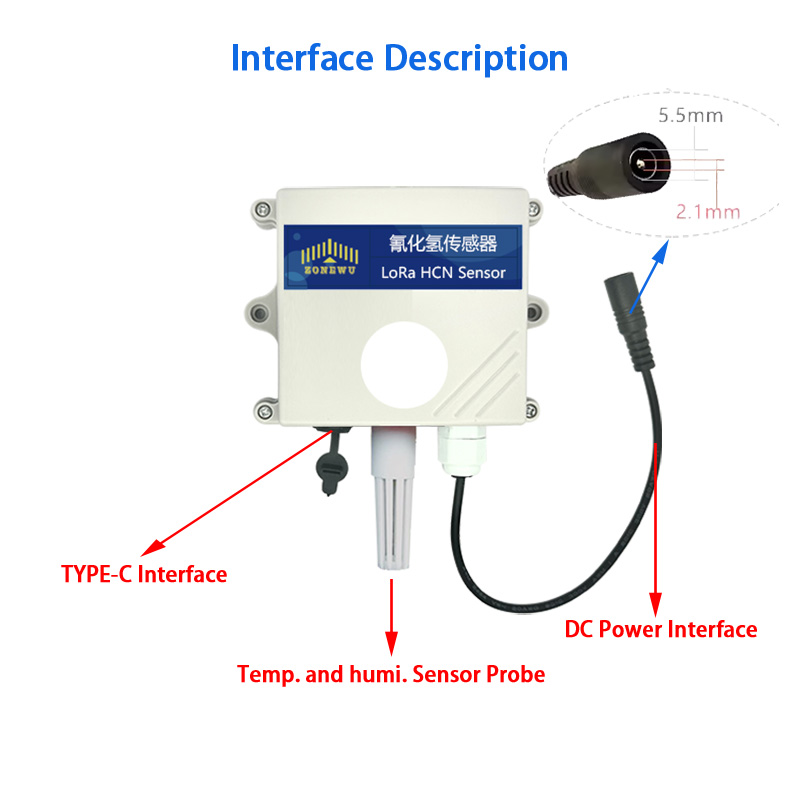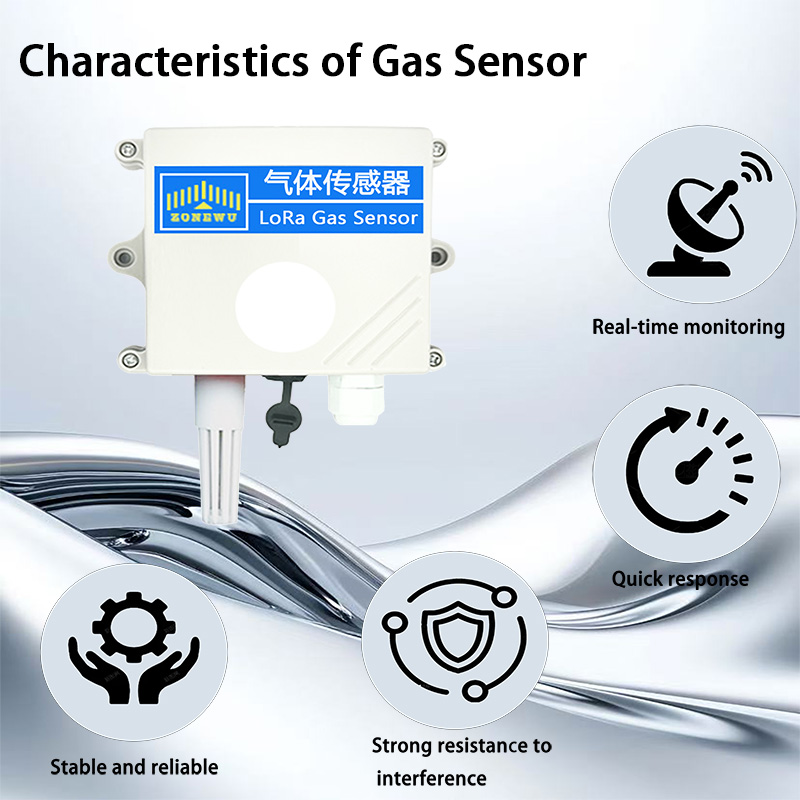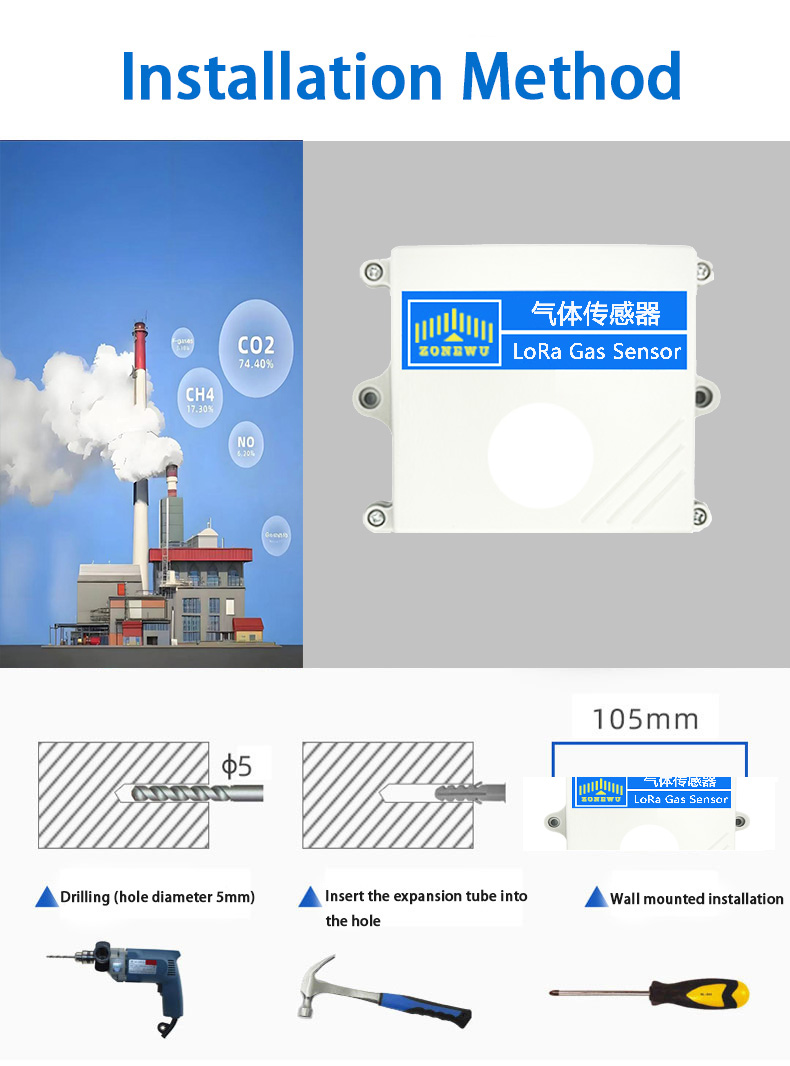xiamen ZONEWU This LoRaWAN Hydrogen Cyanide (HCN) gas sensor is a wireless device that can collect, monitor, and transmit data. It is equipped with a cyanide hydrogen sensor and a temperature and humidity sensor, which can measure the cyanide hydrogen concentration, temperature, and humidity in the environment in real time. The sensor has a high sensitivity, high resolution, and strong stability, and also supports the standard LoRaWAN protocol, which can transmit data over a long distance.
Produktmodell :
LW317-HCNStromversorgungsmodus :
Battery or External DCFrequenz :
CN470/IN865/EU868/RU864/US915/AU915/ KR920/AS923-1&2&3&4MAC-Version :
LoRaWAN 1.0.3Modus :
OTAA Class A/CGewicht :
120gEnvironmental LoRaWAN Hydrogen Cyanide (HCN) Sensor
xiamen ZONEWU The LoRaWAN Hydrogen Cyanide (HCN) sensor is a new type of wireless gas sensor based on LoRaTM spread spectrum modulation technology.
xiamen ZoneWu LoRaWAN Gas Sensor HCN Sensor Features:
This is a wireless gas sensor based on LoRa spread spectrum technology, which can complete data acquisition, monitoring and transmission with one button, and is specifically designed to monitor the concentration of cyanide hydrogen, temperature and humidity in the environment.
Built-in hydrogen cyanide sensor and temperature and humidity sensor, using three-electrode electrochemical technology and high-performance chip to measure gas, the temperature sensor can also automatically "calibrate" the temperature effect, making the data more accurate.
High sensitivity (can catch even small concentration changes), high resolution (precise to the details), and strong stability (resistant to interference and doesn't "drop the chain").
It supports the standard LoRaWAN protocol and can transmit data wirelessly over a long distance using LoRa spread spectrum technology, suitable for large-scale monitoring.
It can set the "safety line" in advance according to the on-site situation. Once the concentration of cyanide exceeds the standard or the data is abnormal, it will immediately "alert" and remind you.
It can be used in chemical plants, electroplating plants, fire scenes, mines, and other places where there may be a risk of cyanide hydrogen leakage, and it can protect safety in real time.
Technical Parameters
| Power Supply | 5~28VDC |
| Weight | 120g |
| Operating Temperature | -20℃~50℃ |
| Measuring Principle | Electrochemistry |
| Lifespan | <2 years |
| Measuring Range |
HCN:(0-100)ppm
Temp:-40~+80 ℃
Humi:0~99.9 %RH
|
| Frequency |
CN470/IN865/EU868/RU864/US915/AU915/
KR920/AS923-1&2&3&4
|
| Mode | OTAA Class A/C(Default: Class C) |
| Reporting cycle |
External power supply:5min(Default reporting cycle)
Report after preheating for 3 minutes when powered on
|
| Communication Protocol | LoRaWAN,LoRa TDMA Networking |
|
Equipment information
(Reference)
|
AppEUI:0000000000000001
DevEUI:aaaa202404150001
AppKey:00001111222233334444555566667777
MAC Version:LoRaWAN 1.0.3
|
Product Applications
1. Long-distance wireless transmission: LoRaWAN technology can transmit data wirelessly to several kilometers away without pulling wires, making it convenient to monitor hydrogen cyanide in large areas such as chemical parks and mines.
2. High precision detection: It is particularly sensitive to hydrogen cyanide, can measure the concentration quickly and accurately, and can get the data in real time. The regularity of numerical changes is stable.
3. Strong anti-interference ability: The electrodes made with special technology are not afraid of other gases "trouble", and can work steadily in complex industrial environments, regardless of electromagnetic interference or temperature and humidity changes.
Detailed Images



Common knowledge of HCN
What is hydrogen cyanide (HCN)? What are the characteristics
Hydrogen cyanide is a colorless, highly toxic gas (some people cannot detect the smell due to genetic differences) with a bitter almond smell, is easily volatile, and dissolves in water to form hydrogen cyanide. It is a typical "asphyxiating poison" that blocks the oxygen supply of human tissues by inhibiting cytochrome oxidase, causing internal asphyxiation, and can be instantly fatal at high concentrations.
What is the safe concentration limit of hydrogen cyanide in the air
Occupational exposure limit value (PC-TWA, 8 hours):
Lethal Concentration:
What are the main sources of hydrogen cyanide? Why is it easily overlooked
Industrial Scenarios:
Concealability:
What interference factors should be paid attention to when detecting the concentration of cyanide hydrogen
Other gas interference:
Temperature and humidity:
Application Scenarios

Industrial production
Waste gas emission monitoring: Conduct real-time monitoring of industrial waste gas emissions to ensure that waste gases meet emission standards and reduce pollution to the environment.

Environmental inspection
Air quality monitoring helps people understand air quality and protect the environment and health by detecting harmful gases such as sulfur dioxide.

Safety protection
In coal mines and tunnels, gas sensors detect toxic and harmful gases such as methane and warn against accidents.
A:Yes,we can provide you with OEM services and design housings and logos.
3.DO you offer free samples?
A:Sorry,we don't offer free samples. After ordering in bulk, we will deduct the sample fee from the second order.
Why Choose ZONEWU